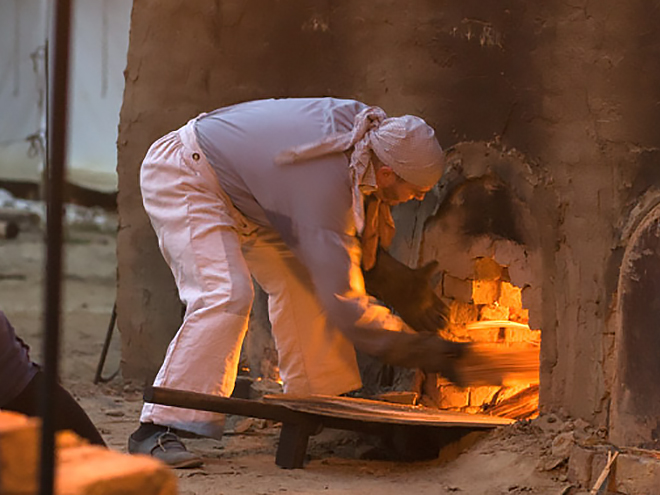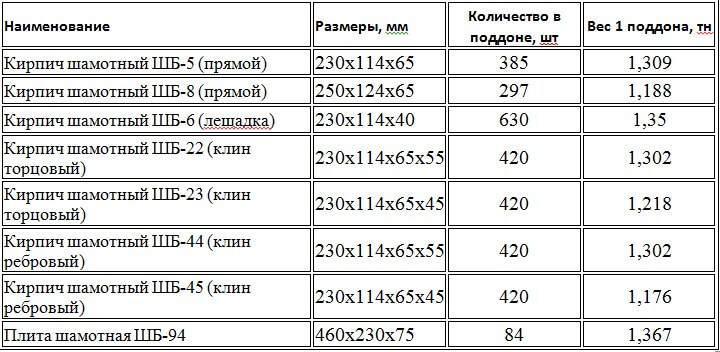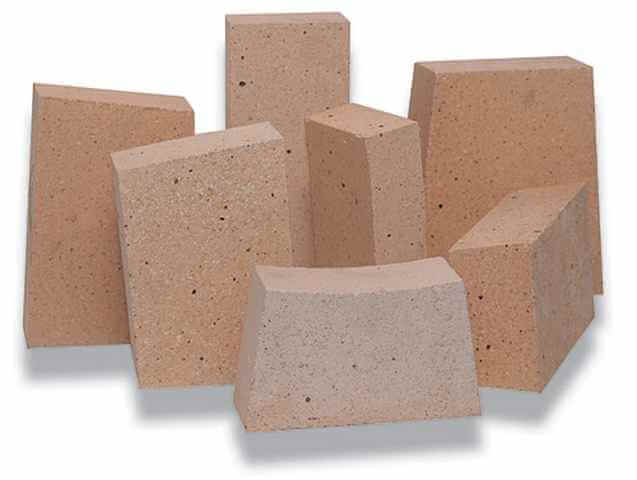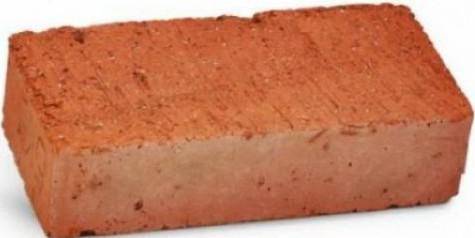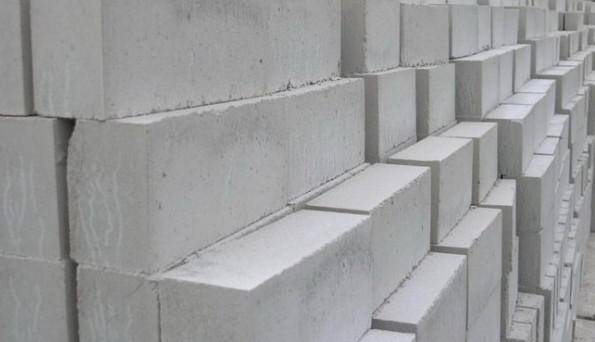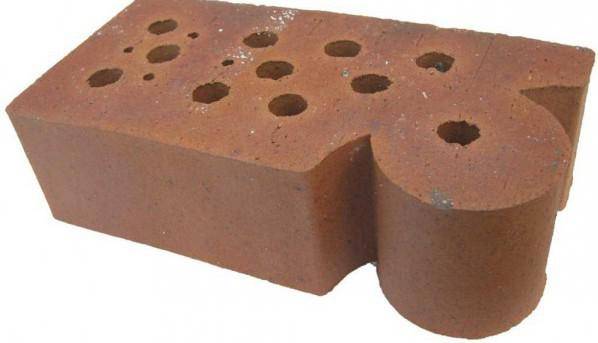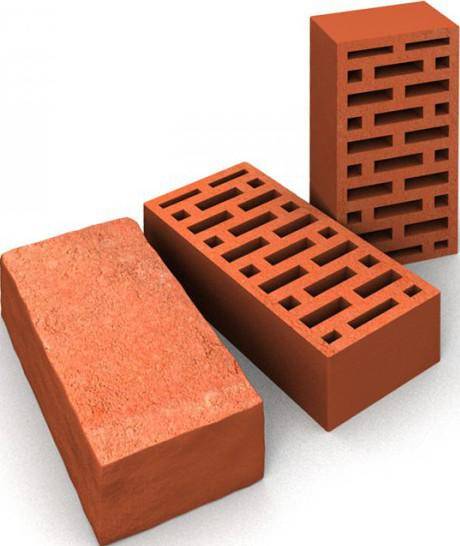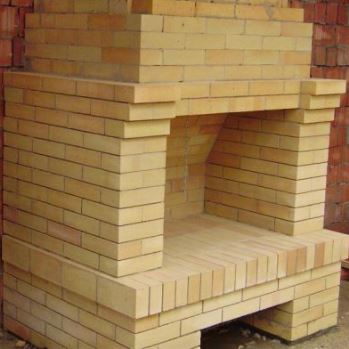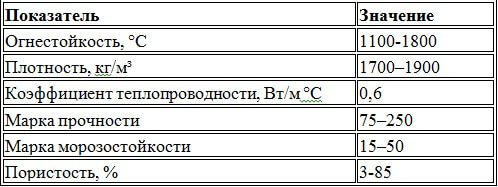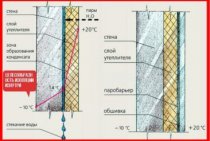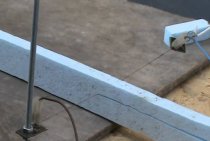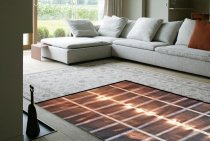Types and quality of bricks
The scope of this material is very wide. Red bricks are used to build load-bearing and self-supporting walls and partitions in buildings of various heights, they fill the voids of concrete structures, lay out foundations, internal parts of furnaces, etc.
Building bricks are called ordinary, but their front (facing) appearance is more appreciated. After firing at high temperature, the material is durable and beautiful, and it is widely used for cladding the exterior walls of buildings and plinths, restoration work and interior design.
Properties of ceramic bricks:
- Strength and durability.
- Frost and moisture resistance.
- Reliable soundproofing.
- Hydrophobicity and fast drying.
- Environmental friendliness. The natural composition of bricks and technology proven over the centuries guarantee the safe stay of people in brick ladies.
- High density (up to 2000 kg/m³ when molded by hand).
The disadvantages include the high cost, which is explained by the complexity of the technology. This material is very durable, houses made of it stand for hundreds of years. If you want to build a quality building, you should not try to make bricks with your own hands - it is impossible to provide a sufficient firing temperature in artisanal conditions.
Specifications
Qualitative indicators of fireclay refractory building materials are controlled by the state standard. GOST installed:
- the composition of the raw material for the production of fireclay, indicating the percentage of impurities;
- thermal conductivity of fireclay bricks;
- porosity;
- dimensions of fireclay bricks;
- geometric parameters and other technical characteristics.
Today, on the building materials market, you can find fireclay refractory blocks made in accordance with the manufacturer's specifications. The performance of such products may differ from the norms established by the state standard. When choosing a building material, it is better to give preference to GOST products, the GOST mark is a guarantee of the quality of the building material.
The main technical characteristics and their indicators of fireclay, established by the standard:
- fire resistance - 1100-1800C;
- density - 1700-1900 kg / m3;
- thermal conductivity - 0.6 W/ms;
- porosity - 3-85%;
- frost resistance class - from 15 to 50;
- strength class - from 75 to 250.
Classification of ceramic bricks
All bricks are classified into different types. For example, a ceramic ordinary brick. This type is the most common and is used in the construction of buildings and various kinds of buildings. It is characterized by the following features:
- frost-resistant;
- lasting;
- has excellent density.
Its outer side has a geometric pattern, which is necessary for adhesion to the cement mortar. Such a brick is resistant to temperature changes, is not susceptible to destruction when exposed to weather conditions, and is applicable in regions with an unfavorable climate.
It is usually red in color but is sometimes available in yellow or apricot. It depends on the type of clay used in the manufacture of bricks.
If we talk about the aesthetic appearance, then when purchasing, it is recommended to purchase the entire batch necessary for the construction at once, since the color of each batch may differ.
This brick is produced in 2 types:
- hollow;
- whole.
Solid products are more durable than hollow ones.
Brick ceramic facing is used for decoration and protection. Basically, red clay is used in its manufacture, in rare cases - white. As a result, the facing material can have various color shades, such as white, yellow, pink, and sometimes dark brown.
And the product of yellow, apricot and white color is obtained by using clay supersaturated with lime, which is very rare.
Some manufacturers, saturating the elements with light tones, add lime during manufacture, which affects the increased moisture absorption of the front material.
Dark brown is obtained with the help of additional pigments. To obtain brown and terracotta shades, manganese is added to the clay during manufacture.
Facing elements perform the function of a shell that protects the walls of the building from various kinds of influences (mechanical and natural), so they must be of high quality:
- increased strength is necessary for stability against mechanical shocks and under load from the upper rows;
- minimal moisture absorption: should not absorb moisture, so that later it does not penetrate into the building;
- frost resistance: must withstand repeated freezing and thawing;
- color fastness: should not fade under the influence of sunlight and ultraviolet rays.
Also, ceramic bricks are not deprived of their advantages. Its advantages include the following:
- good sound insulation, since this building material is carried out in compliance with the rules of SNiP for noise protection;
- environmental friendliness: for the manufacture of elements, natural material is used - clay, in this regard, it is non-toxic;
- has low thermal conductivity.
Description
According to GOST 530-2012, ordinary bricks are obtained from ordinary clay, which before that goes through a purification stage. Also, various impurities are used for manufacturing. After that, the finished raw material is pressed into molds and delivered for firing at a temperature of +1000 degrees. As a result of this procedure, red material can be obtained.
If ordinary and fireclay clay was used during production, then the resulting product is called fireclay. It is a refractory artificial stone that can be used in the construction of stoves and fireplaces.
You can find out the weight of a red brick from this article.
When using clinker and ordinary clay, it is possible to obtain clinker. The resulting product is characterized by high strength and heat capacity. The product is used in the construction of the basement and basement. Clinker can also be used in the arrangement of road surfaces and in the decoration of internal and external walls of houses.
You can find out how much silicate white brick costs in this article.
On the video - the size of an ordinary brick:
What is the weight of silicate brick indicated in this article.
Advantages of clay brick

The digital designations in the marking as they increase indicate the better quality of the product in comparison with a lower brand or class. However, sometimes it is advisable to use just such instances in order to remove the load from other load-bearing elements. Very often, for reasons of thermal protection, external walls have an excessive, unreasonably high thickness and strength, and, as a result, a large weight that crushes and destroys the foundation. Therefore, instead of a solid brick, it is advisable to use porous, porous-hollow or hollow, which have a lower volumetric weight and are not inferior in strength to their solid counterpart, although they have lower thermal conductivity. In addition, they are sometimes larger in size, which reduces material consumption and the cost of 1 square. m masonry.
What is ceramic brick made of?
//www.youtube.com/watch?v=ki5niVl1zoI
The main substance that makes up ceramic bricks is ordinary clay - a mineral mass that acquires plasticity when water is added, retains its shape after drying and hardens to a stone state when fired.Clay is ubiquitous, but even in one deposit, its characteristics may vary depending on the depth of the layers. The basis of clay raw materials, as a rule, are 4 minerals: kaolinite, illite, montmorillonite and quartz. Clay properties taken into account when making bricks:
- Plasticity is the ability to change shape under the influence of force without collapsing and retain it after the termination of the action. There are high-, medium-, moderate- and low-plastic, as well as non-plastic clays.
- Binding ability - preservation of plasticity when adding non-plastic inclusions. It is measured by the ability to bind the amount of sand expressed as a percentage (from 20 to 80) to its own weight.
- Air and fire shrinkage - change in the size of samples, respectively, during drying and firing.
- Caking - the property of hardening to a stone-like state when heated. Clays with a sintering temperature of up to 1100°C are considered low-temperature, within the range from 1100 to 1300°C - medium-temperature; over 1300°C - high-temperature.
- Refractoriness - the ability not to melt when heated. High refractoriness (not lower than 1580 ° C) is possessed by pure highly plastic kaolinite clays used for the production of porcelain. Refractory clays are used for the production of sewer pipes and facing bricks with a small amount of impurities and fire resistance from 1350 to 1580 ° C. Fusible clays are considered to be non-uniform in composition, with fire resistance below 1350 ° C, used to make bricks, blocks and tiles. The degree of suitability of clay for the manufacture of specific products depends on its mineral, chemical and granulometric composition.
Regulating additives
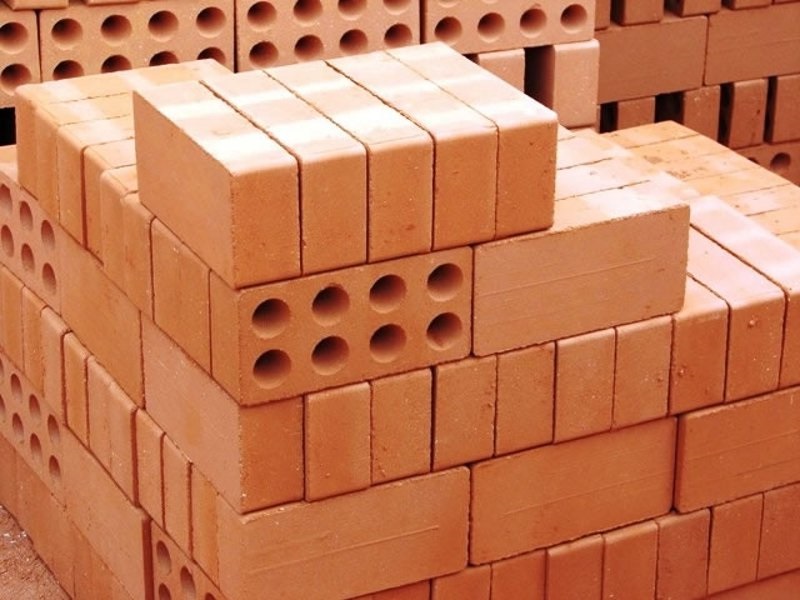
- emaciated - inorganic substances that facilitate mass molding and reduce shrinkage: sand, ash, slag;
- burnable - organic inclusions that reduce density and increase porosity: sawdust, powdered coal and peat;
- special ones - iron-bearing ores and sandstone that regulate the firing temperature, facilitate the formation of ulphite-alcohol bard, color metal oxides in the finished brick in the desired color.
Raw material processing steps
Before becoming a finished product, the clay that is part of the red brick without fail goes through the following steps:
- extraction and preparation;
- molding and drying;
- burning.
Usually, clay mined in a quarry is transported to the processing site, where primary grinding and rough cleaning of foreign inclusions take place. Then drying, final crushing, sifting and moisture necessary for subsequent pressing up to 9-12% are carried out. The molding press gives the powder the required shape, after which the raw material is fed into the drying chamber, where, due to the gradual increase in temperature, there is a uniform evaporation of water that does not disturb the texture of the brick surface.
 Roasting, consisting of heating, firing and cooling, takes place in a special furnace, where the prepared raw material is fed by a conveyor.
Roasting, consisting of heating, firing and cooling, takes place in a special furnace, where the prepared raw material is fed by a conveyor.
Thus, clay turns into a building material with the necessary properties - bricks.
In addition to clay, the main raw material for the manufacture of ceramic bricks and wall blocks can be industrial waste generated during the enrichment of coal, as well as during the combustion of ash fuel from thermal power plants, consisting mainly of aluminosilicate glass, clay and quartz. The difficulty of using such raw materials lies in the instability of its properties.
Advantages and disadvantages
Among the positive properties of refractory material, the following are noted:
- relatively small weight;
- copes well with temperature changes;
- withstands the impact of aggressive external factors;
- good heat capacity and inertia, manifested in rapid heating and slow cooling;
- variations in shape and size;
- the ability to withstand temperatures up to 1690 ° C inclusive;
- attractive appearance and satisfaction of any requests due to the presence of different shades and textures.
The main disadvantages are the following points:
- the problem of cutting and sawing, since the brick has increased strength characteristics;
- high price.
A few words must be said about alumina (fireclay) bricks. Among other types, it has a special strength and is distinguished by an affordable price. The refractory material is based on a special clay of the aluminosilicate type, the properties of which are enhanced by the addition of powder from graphite and coke substances.
Read more about the properties of fireclay bricks in.
Dimensions and shape
It is a rectangular parallelepiped with straight edges and corners. Clay brick has the following dimensions: 250 × 120 × 65 mm. Firing is fraught with inevitable shrinkage, so there are tolerances, mm:
- Length - ±6.
- Width - ±4.
- Height - ±3.
- For curvature:
- surface — ±4;
- ribs - ± 5.
A frequent disadvantage of the form is the blunting and repulsion of corners and ribs. In one product, up to two such defects of no more than 15 mm are permissible. This disadvantage does not affect the strength of the masonry, but it requires a greater consumption of mortar to fill the irregularities. The standard dimensions of clay bricks can only vary in height: one and a half (88 mm), double (138 mm). There are other non-standard brick sizes:
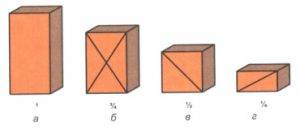
- quarter;
- octal;
- restoration.
Hollowness classification:
- A full-bodied specimen may have technical holes, up to 13% of the total volume.
- Slotted up to 45% holes. Its heat-insulating ability is higher and this allows to reduce the thickness of the wall without loss of strength.
Marking
For the convenience of classification and ease of selection of this building material, a marking has been developed, thanks to which you can immediately determine the properties of the material. It reflects the dimensions of products, temperature properties and technical characteristics.
The most popular brands of fireclay bricks: SHA, SHB, SHAK, SHUS, SHV, PV and PB.
Using the example of a bar marked ShB 5 SL, we will decipher the data from the manufacturer.
 Sh - a letter indicating that the product belongs to the type of fireclay aluminosilicate bricks; B - brick, made according to the requirements of GOST, and belonging to fire resistance class B. There is also class A.
Sh - a letter indicating that the product belongs to the type of fireclay aluminosilicate bricks; B - brick, made according to the requirements of GOST, and belonging to fire resistance class B. There is also class A.
Fireclay brick of class A can withstand temperatures up to 1350 C, and class B - 1400 C.
The GOST mark guarantees the compliance of the building product with the list of specified parameters: integrity, compliance with dimensions, strength, operating temperature.
If there is a number in this place, without the presence of a letter after Ш, it means that the fireclay brick was produced according to the manufacturer's specifications.
The figure itself means the geometric parameters indicated in the table below. That is, our example corresponds to the dimensions of 230x114x65 mm.
SL - indicates the manufacturer of the product. SL here is the Sukholozhsk refractory plant, and BG is Bogdanovichsky.
There is also a deeper classification within each brand: by shape, size, thermal conductivity.
Table with common types of fireclay bricks, according to GOST 8691-73:
In addition to the standard rectangular shape of fireclay bricks, there are also trapezoidal and wedge-shaped ones.
Varieties of ordinary brick
Brick is a product that is characterized by high strength characteristics. In addition, the building material has a long service life. If the masonry process was carried out taking into account all the requirements, then the constructed structure has an unlimited service life.
What are the dimensions of one-and-a-half silicate bricks are indicated in this article.
The classification of this product is carried out taking into account the type of clay used. As a result of this, it is worth highlighting such products as white, red (ceramic), clay and decorative stone. The most ancient of all types of products is red brick.
Red
Such a product is obtained by firing pressed clay briquettes. For a very long time and often used in the field of construction in the construction of foundations, walls and partitions. It is also actively involved in the construction of furnaces and protective structures. This type of ordinary product is today considered universal.
What sizes of ordinary ceramic bricks are indicated in this article.
An excellently burnt red stone makes a sonorous and clear sound during impact. If the product is burnt, then when choosing it, you can consider the black core. Such a stone will not be widely used; it can only be used when laying foundations. A solid red brick of classic dimensions is characterized by a weight of 3.5-3.8 kg.
What ceramic brick looks like according to GOST 530 2012 can be found in this article.
For red brick, its own marking has been developed. Thanks to it, it is possible to decipher what quality characteristics a certain product has. In the marking of red brick there is a number indicating the pressure that the product can withstand in compression. The pressure is expressed in kg/cm2. Weigh one cube of material approximately 1700 kg. 1 m3 contains 480 bricks.
White
A silicate base is used to obtain this product. On the basis of this, such a product was called silicate. White stone is characterized by light weight, it has less strength compared to red. In addition, silicate brick is inferior to red in its versatility.
About what size of a white one-and-a-half brick is indicated in the description of the article.
It is possible to use such a product only in the construction of walls and partitions. For example, it is not worth using such a stone when erecting structures where high temperatures are observed. And about what temperature is optimal to put brick read the article.
Decorative
This type of product is produced specifically for the implementation of responsible events. As a rule, this refers to the construction of walls, which place high demands on the surface of the wall. Such a product has a strictly regular shape, the brick is even, has a glossy surface.
The article describes the standard brick sizes.
Due to its attractive appearance, such a stone was called "facade". If you use decorative brick, then you can get not only beautiful masonry of external walls, but also use it when laying rooms without further finishing the erected structures
When using decorative bricks for building inside the house, special attention should be paid to cutting the seams
Clay
Ordinary clay stone is a building material that is produced in the form of a parallelepiped. Such a product is characterized by strictly established dimensions. Low-melting clay is used as a raw material, to which lean additives are sometimes added.
If the brick is produced at the factory, then local raw materials are used there. Clay is mined in open pit mines. For these purposes, excavators are used. After that, the resulting raw materials are sent to the plant.
The article describes the size of a full-bodied ceramic brick.
How many red bricks fit in a standard pallet is described here.
Manufacturing features
Production methods are divided into such as:
- semi-dry pressing;
- incomplete firing or only thermal drying;
- baking clays and their mixtures.
Clay without impurities is rarely found in nature. Products made from too oily or, conversely, lean clay will be fragile.Correct proportions are very important for obtaining high-quality building materials. The manufacturing process has the following algorithm: the prepared clay mixture is put into molds, then the brick is dried (from 6 to 15 days). At this stage, the production of raw material ends. Firing bricks in special ovens at a temperature of 900-1000 ° C will turn clay into ceramics. Melting time and temperature vary by brand and grade.
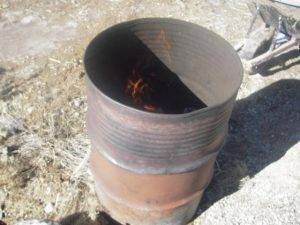
In artisanal conditions, it is also possible to make a kiln from an iron barrel, which is installed above a pit with firewood. Lay raw bricks in a barrel, leaving gaps between them for better baking. It should be heated with a fire diluted under it for 20-22 hours, then about 6 hours the barrel should cool down on its own. Extract finished products.
Prices
In addition to the fact that ordinary brick has excellent strength characteristics, durability and aesthetic appeal, it can also boast of a low price. One material costs about 6-14 rubles, it all depends on the type of product you have chosen.
Brick is a material without which it is impossible to imagine any construction. This is a universal product that can be used in the construction of various structures. Many builders choose this material because it is possible to get a high-quality and durable building that will last a long time at a decent price.
Peculiarities
The characteristics of refractory bricks are strikingly different from those endowed with ceramic or silicate counterparts. The main component of the refractory bar is clay. All other ingredients are special additives, on which the quality, properties and type of building material depend. But all additional substances without fail have the ability to retain their original properties under high temperature conditions.
Refractory bricks are often used in industrial production, therefore, they must meet the requirements for quality and properties. Any manifestation of defects will lead to a malfunction, which means large financial losses.
An important feature of such a brick is to ensure fire safety: it is a material that is able to isolate fire.
Properties inherent in all types of refractory bricks:
- The low level of thermal conductivity ensures the preservation of heat inside the design of heating equipment.
- The presence of thermal inertia. Refractory brick heats up quickly, but cools down slowly.
- Ability to resist hot gas, slag, metal.
- The optimal level of heat capacity for the accumulation of thermal energy and its subsequent transfer.
- Increased resistance to high temperatures, while maintaining all the characteristics of the material.
- Invariance of volumetric parameters. Such a brick is practically not subject to shrinkage and growth: these indicators remain in the range of 0.5-1%.
What are fired bricks made of?
Today, a variety of materials are widely used in economic activity - bricks and blocks obtained using the following non-firing technologies:
- autoclave hardening of lime-sand mixture;
- hyperpressing a mixture of crushed limestone rocks with water and cement.
Regardless of the type of feedstock, they are united by the absence of high-temperature processing of brick blanks.
silicate brick
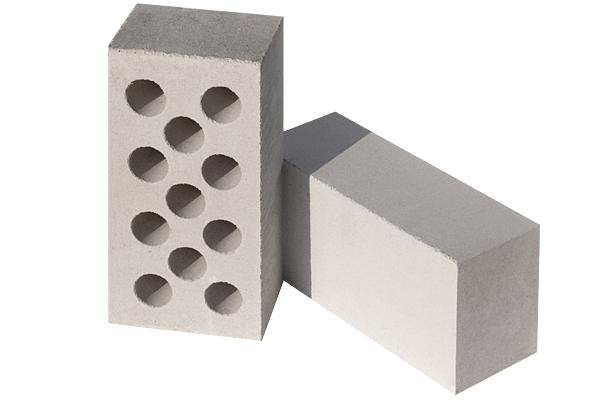
Mixture components
Sand is a natural or artificial (industrial waste) loose mass of homogeneous small, from 0.1 to 5 mm, grains of various minerals.The quality of the sand included in the brick determines the quality of the finished product and the features of the production technology. The geometric shape and texture of the surface of the sand grains are important for the ease of giving the raw mixture the desired shape and the intensity of interaction with lime when heated in an autoclave. Sharp-angled mountain sands, in contrast to smooth river sands, adhere better to lime. Quarry sand must be pre-cleaned from foreign inclusions.
The next component is lime, obtained by crushing to a size of 40-100 mm and subsequent firing at a temperature of 1100-1200 ° C of rocks containing at least 90% calcium carbonate - chalk, limestone, limestone tuff and marble. Under the influence of temperature, limestone breaks down into carbon dioxide and lime. At all stages of the manufacture of silicate bricks, water from artesian wells is used.
Also in brick production, lime-slag and lime-ash mixtures are used with complete or partial replacement of sand with silica-containing industrial waste - ash from thermal power plants and slag. Made from waste and ordinary silicate bricks are identical in their qualities.
Brick obtained by hyper pressing
//www.youtube.com/watch?v=HrJ-oXlbD5U
The starting material for non-fired bricks are mixtures consisting of Portland cement or lime as a binder, various mineral fillers (sand, crushed shell rock), water and inorganic dyes. In non-firing technologies, water, hydrating the components of hydraulic binders, is necessary to artificially create a stone-like structure, which is why the disadvantage of such bricks is their low heat resistance. When critical values are reached, as a rule, above 300 ° C, the reaction of the release of chemically bound water is triggered, due to which the brick quickly loses its strength.
Technology features
At the stages of preparation of raw materials and molding of blanks, non-firing technology resembles the manufacture of concrete blocks, however, the initial material of such a brick includes a filler compacted by pressing - crushed shell rock, stone processing waste, etc. Since water is consumed only for cement hydration, it requires a much smaller amount. The final form is given by hyperpressing - strong, up to several tons per 1 sq. cm, by compressing the mixture in a special form, after which the products are stored or sent for steaming in order to speed up the process of acquiring the required strength.
The simplicity of the technology, due to the absence of expensive high-temperature stages, made it possible to make it ubiquitous, often to the detriment of the quality of the finished product.
These are the main materials and technologies used for the manufacture of a variety of bricks, blocks and facing materials used in residential and industrial construction.
//www.youtube.com/watch?v=theYzuMyhIw
Scope of application
Ordinary or building clay bricks are often used for exterior and interior walls, which in the next step will be plastered or lined. The surface may have a geometric pattern for better grip, but is not very resistant to the aggressive effects of water and frost.
A wide range of colors and shades of ordinary ceramic bricks and various types of corners (rounded or straight) make it a quality material for finishing work and creating complex shapes. It is able to withstand water, frost, and is suitable for all outdoor applications. A hollow type is often used, which increases thermal conductivity.
Clinker facing bricks are comparable in strength and durability to granite. According to GOSTs, it withstands acidity of at least 95%, and water absorption - no more than 2%.It is made only from refractory shale grades of clay, which have good plasticity and contain a minimum amount of additives. Such a product is fired at higher temperatures (1200 ° C) until completely baked. They are paved with paths, steps, parking spaces.
Press powder manufacturing technology
Press powder is a highly concentrated clay substance. In its production, the slip method is used. In this case, the clay mass is diluted with boiling water into a slip, where a moisture content of about 45% is required. Using a pressure of 0.25 MPa, foreign stone impurities are determined and removed. Further, having cleaned the mass, place it in the sludge pool. There it is processed by a compressor and placed in a spray dryer. In the finished composition, the moisture content should not exceed 10%.
Then pressing is done. When processing ceramic bricks, you can apply a variety of pressing modes:
- unilateral and bilateral;
- single and multiple;
- percussive and smooth.
After pressing, the raw material must be dried in special dryers, where the temperature is initially set at 120-150°C. The drying process lasts up to 24 hours. After exiting, the moisture content of the brick should be 6%.
As soon as the drying stage is completed, the product is placed in an oven and fired at a temperature of 900-1000°C.
Qualitatively made products have a clear rectangular shape and the front side with pronounced edges. In rare cases, the edges are uneven and the corners are bevelled. Ceramic bricks are made with through and incomplete voids, which are vertically and horizontally oriented.
Ceramic brick found its purpose in almost all buildings:
- in laying the foundation;
- in the construction of load-bearing walls and partitions;
- for the device of furnaces and fireplaces;
- for building cladding.
Specifications
Qualitative indicators characterizing fireclay bricks are strictly controlled by the state. The GOST contains indicators that reflect the weight of fireclay bricks and its dimensions, the composition of raw materials with a percentage of aluminum oxide, as well as technological properties: strength, geometric parameters, fire resistance, porosity.
The main indicators are shown in the table:
In the manufacture of products, many manufacturers are guided by their own specifications instead of the conditions prescribed by GOST. Therefore, when choosing a material, the question arises which brick to take. Indeed, according to a number of characteristics, products manufactured in accordance with GOST and according to the manufacturer's specifications very often do not coincide. In this case, it is better, if possible, to purchase goods with a GOST mark, since it is of better quality.
As for the geometric parameters, GOST specifies the size of a standard rectangular product 230x113x65 mm, and this is considered the optimal material for the construction of brick structures. But today other dimensional characteristics are also acceptable, so the market is filled with a variety of products from different manufacturers.
The mass of products also has different indicators, and ranges from 2.8 kg to 4.5 kg, with an allowable weight according to GOST - 3.7 kg. When purchasing, do not forget about this, because the thermal conductivity of the material depends on the mass. To keep the heat in the room, you need to choose a material with a larger mass, because a small weight increases its thermal conductivity.
The quantitative content of aluminum oxide in the composition of the building material depends on the resistance to chemicals, alkalis and high temperatures. The content of this element in the composition affects the structure of the material, making it porous. A porous brick heats up for a long time, but it also cools down longer than usual, retaining the resulting heat.
At the same time, strength decreases with increasing porosity. Therefore, it is worth choosing 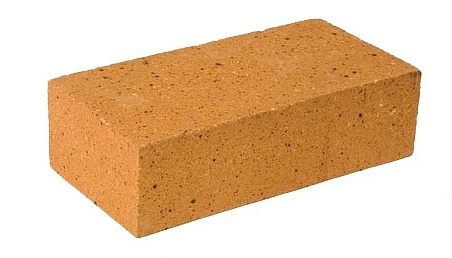
You can determine the porosity of a brick by simply holding various options in your hands.
Summing up, we can say that when choosing such a building material, production standards, dimensions, weight, aluminum oxide content and density should be taken into account.
The principle of manufacturing ceramic bricks
Brick production is carried out by 3 methods:
- The plastic method is considered the most applicable. Using this method, a clay composition having a moisture content of 17-30% is extruded from a belt press and then fired.
- To use this method, raw material is required. It is molded from clay mass, which has a moisture content of about 10%. It is molded by strong pressing. But the material made by this method should not be used for buildings with high humidity.
- Semi-dry pressing method. This method involves pressing a powder composition under pressure up to 40 MPa.
